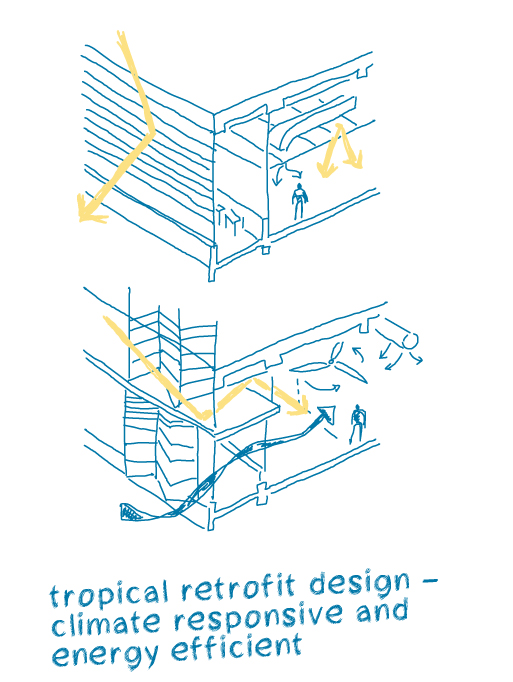Carbon Transformations at the Equator – NUS SDE 1 & 3, Singapore, Singapore


SDE 1 & 3 are a two net-zero, low carbon renovation projects at the NUS School of Design and Environment in Singapore. The goal was to create spaces of inspiring architectural quality while simultaneously designing a building that operates on a super-low-energy-demand basis. Transsolar explored strategies for operational energy and delved into the impact of avoiding carbon emissions by retaining the base buildings´ embodied carbon. The design team focused on the potential of the base buildings to create excellent environmental conditions for people through improved daylight access and autonomy, thermal comfort, natural ventilation, and indoor air quality. The base buildings could deliver these qualities by reusing the building structures, upgrading the facades, and introducing innovations in designing for thermal comfort in the tropics.
The 22.000 m² structure for the existing base buildings was built in the late 1970s when responsibility for building performance was shifted from architecture to HVAC systems. This resulted in the allocation of significant false ceiling volumes of up to 1.8 m height for the ductwork of the cooling and ventilation system. In order to take advantage of the existing structure and improve the spatial quality, the removal of the suspended ceilings was proposed.
To improve and optimize environmental conditions, the design team studied innovative concepts to create a sequence of outdoor, transitional, and indoor spaces. The layout of thermal zones in the different program areas was organized as per their environmental requirements. Many areas were purposefully designed as outdoor areas, protected against wind, rain and glare, but were also nicely daylit and provided with excellent natural ventilation. Major program areas now operate with a wider temperature and humidity range with hybrid cooling; that is, a combination of ceiling fans and a single-pass system designed for excellent fresh air supply rates. The slightly increased room air temperatures result in smaller differences between indoor and outdoor spaces. This allows for a gentle switch from a tempered mechanical air supply to natural ventilation and significantly increases the value of designing facades and thermal zoning of tropical buildings for natural venti lation. Furthermore, the hybrid cooling concept offers relevant energy and carbon savings.
The external shading is an essential part of the identity of the architectural ensemble. Therefore, many options for the reconfiguration of the external lamellas were studied, with the goal of reducing glare while optimizing daylight and balancing solar gain. The potential of the combined effects for daylight turned out to be high, offering excellent daylit spaces and reducing the energy demand for artificial lighting. For Singapore, it is still unusual for a university building to be maintained and fundamentally renovated. In order to analyze the savings in avoided CO2 emissions, a life cycle analysis (LCA) was therefore carried out and the CO2 emissions built into the original structure estimated and related to emissions of future operation.
"Calibrating the Carbon Problem" Paper:>
2024 Society of Façade Engineers (SFE) Design and Engineering Project of the Year –International Sustainability award
2025 AIANY Design Awards Merit









